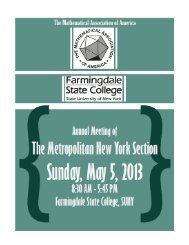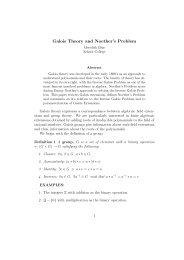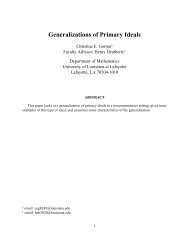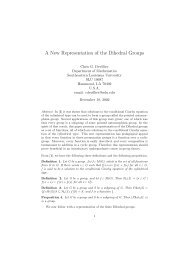Presentation Abstracts - MAA Sections
Presentation Abstracts - MAA Sections
Presentation Abstracts - MAA Sections
Create successful ePaper yourself
Turn your PDF publications into a flip-book with our unique Google optimized e-Paper software.
In this talk I will introduce the Gini coefficient as a measure of income inequality. I will then show results from several<br />
statistical tests on this data, and we will attempt to answer the question that is the title of this lecture. Then we will see<br />
new questions concerning the flat tax that can and should be studied.<br />
UGF.5 Jordan Taylor Austin Peay State University<br />
Robert French<br />
Extended Backwards Differentiation using Trig Basis for oscillatory problems<br />
In this presentation, we derive an Extended Backward Differentiation Formula with trignometric basis functions. The<br />
method is implemented on oscillatory problems and the results obtained are compared with existing methods in the<br />
literature.<br />
UGC.2 Lain Tomlinson Cumberland University<br />
Chris Fuller, and Sarah Pierce<br />
Making Musical Serialism From Mass Spectrometry and Nuclear Magnetic Resonance<br />
Using mathematic principles, music was generated from applications such as mass spectrometry and nuclear magnetic<br />
resonance (NMR). Research was conducted on different methods such as sound formulas, frequency formulas, and<br />
Fourier series that could be used on mass spectrometry and NMR data. The data that was used was obtained from the<br />
Spectral Database for Organic Compounds (SDBS) and included caffeine, adenine, and 2,4,5-trifluoro-1,3<br />
phenylenediamine. Using the recorded data and the formulas, tones were produced with MATLAB. The music, serialism,<br />
is tones produced from data sets. The results were atonal at this time, but further research will hopefully yield results that<br />
are more melodic.<br />
GT3.1 Anh Tran Georgia Southern University<br />
Yan Wu<br />
Adaptive control of Lorenz system to non-trivial equilibrium points<br />
The complex Lorenz system is a simplified nonlinear dynamical system, which is derived from the Navier-Stokes<br />
equations that govern a closed thermal convection loop. The Lorenz system is chaotic for large Rayleigh number. In this<br />
chaotic regime, we implement a linear state feedback controller to stabilize the state trajectory at its original non-trivial<br />
equilibrium. The state variable for feedback is easily measurable. The system is proved to be globally asymptotically<br />
stable with a low feedback gain. The stability bound is improved over the previous result. We present numerical<br />
simulations to demonstrate the stability, transient and steady state responses, and the performance of the state feedback<br />
controller.<br />
GT1.6 Will Trott Georgia Southern University<br />
The Default of Contraction and Regularity<br />
The category CONV, with convergence spaces as objects and continuous maps as morphisms, is generalized by the<br />
category CAP, in which convergence-approach spaces are objects and contractions are morphisms. This presentation will<br />
focus on introducing these two categories as well as introducing a recent generalization of a theorem of Wolk.<br />
CLH.4 John Wagaman Western Carolina University<br />
Statistics and Service Learning in the Campus Garden: A Preliminary Report<br />
We have several courses at our university which serve as introductory courses in statistics for many students; among these<br />
are a service course in applied statistics and a graduate course in experimental design. In Fall 2012, we started our<br />
involvement with the Campus Kitchen Garden, a student-run facility and organization under the Center for Service<br />
Learning at WCU. In this talk, we will describe our continued work with this organization through our statistics classes in<br />
assisting the garden to grow food for the local food bank.<br />
RES1.2 Brian Wagner UT Martin<br />
Ascending Subgraph Decompositions in Oriented Complete Balanced Tripartite Graphs<br />
n<br />
1<br />
A digraph D with k<br />
2<br />
arcs (0 k n) has an ascending subgraph decomposition (ASD) if there exists a<br />
<br />
partition of the arc set of D into n sets of size 1,2,3, , n 1,<br />
n k such that the digraphs D1 , D2, , Dn<br />
1,<br />
Dn<br />
induced

















